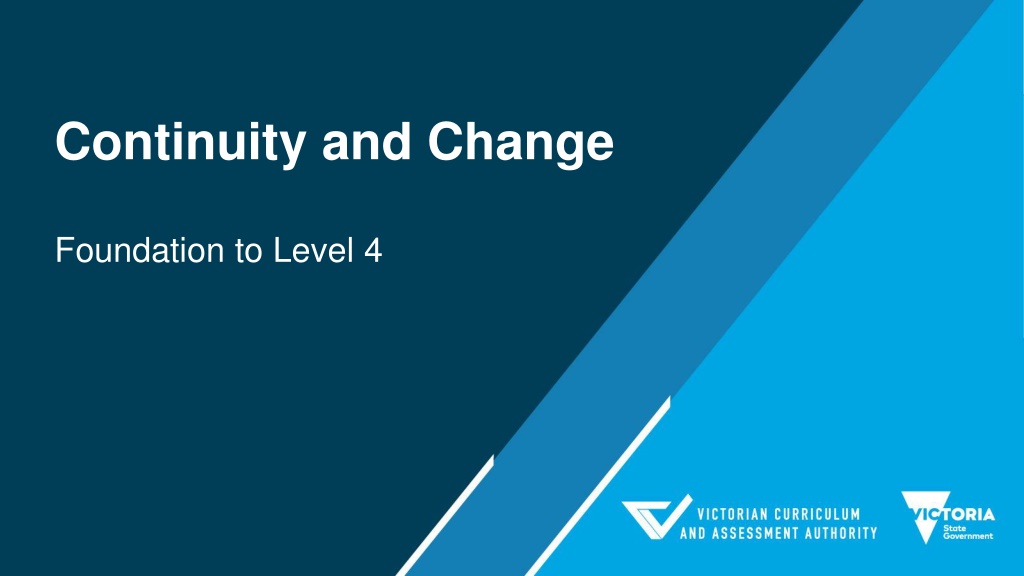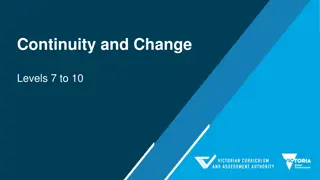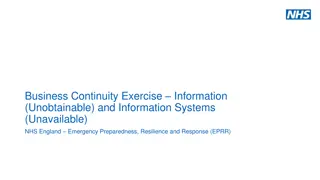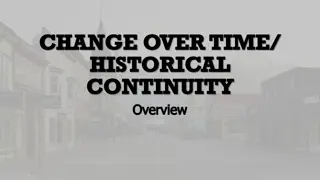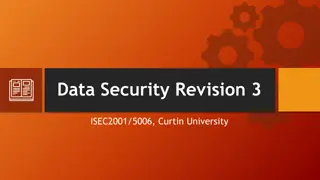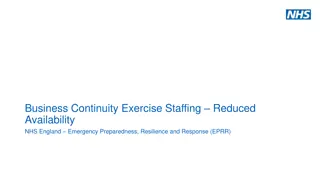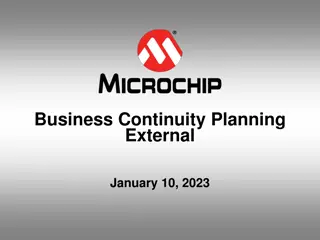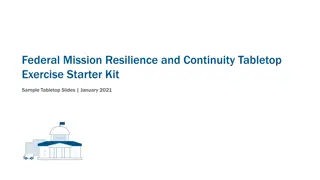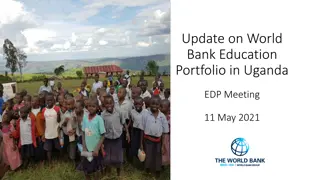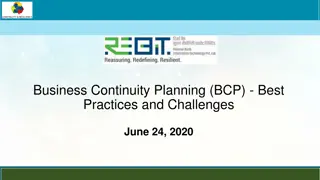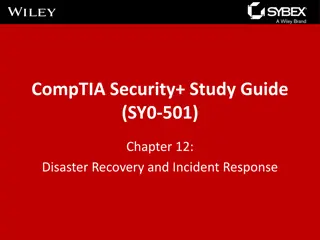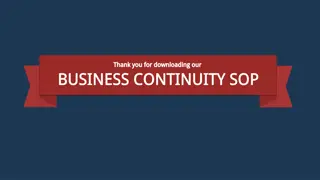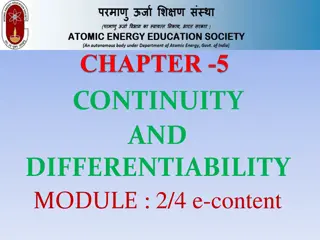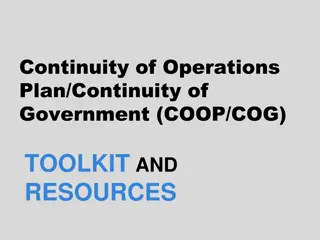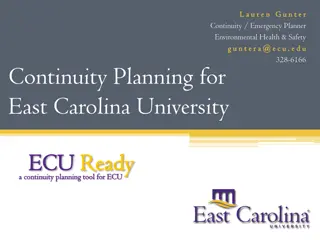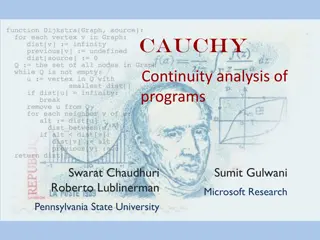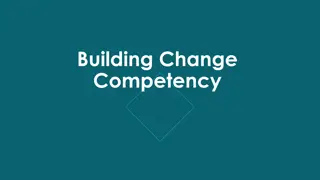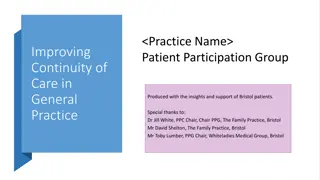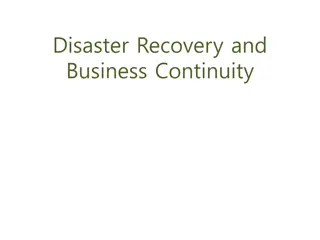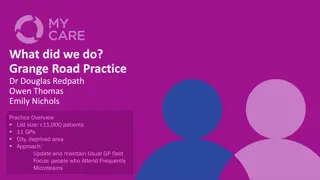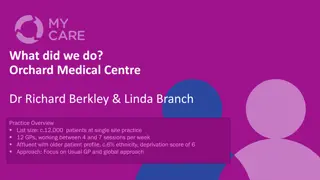Continuity and Change in History Education
Understanding history involves recognizing both continuity and change over time. This exploration delves into how students develop historical thinking skills, identify key turning points, and grasp the significance of events in shaping the past. From foundational concepts to higher levels of analysis, the curriculum emphasizes the ability to discern patterns of continuity and recognize factors driving historical change.
Download Presentation

Please find below an Image/Link to download the presentation.
The content on the website is provided AS IS for your information and personal use only. It may not be sold, licensed, or shared on other websites without obtaining consent from the author.If you encounter any issues during the download, it is possible that the publisher has removed the file from their server.
You are allowed to download the files provided on this website for personal or commercial use, subject to the condition that they are used lawfully. All files are the property of their respective owners.
The content on the website is provided AS IS for your information and personal use only. It may not be sold, licensed, or shared on other websites without obtaining consent from the author.
E N D
Presentation Transcript
Continuity and Change Foundation to Level 4
Introduction Provocation Continuity and Change in the curriculum context Continuity and Change in Victorian Curriculum History Continuity and Change in the continuum of learning Towards the classroom Examples of practice Conclusion
History is often defined as the story of change over time. But history is more complex: some things don t change at all; some things change quickly and then slowly; and, at any given moment, some things change while others remain the same. Peter Seixas and Tom Morton, The Big Six Historical Thinking Concepts
Continuity and Change in Victorian Curriculum History
Victorian Curriculum History Learning in History Achievement Standard Skill/Concept Historical Knowledge
Learning in History Developing students ability to make sense of the past includes developing the ability to identify when the change occurred and when things continued unchanged. To identify continuity and change students should understand the significance of events, ideas, people and groups. The use of narratives and timelines as a starting point helps support students understanding of the sequence of events. Students should be able to identify turning points that caused change and use language to describe the speed, rate and the extent of change that was brought. Exploring questions allows students to understand that continuity and change involve multifaceted factors. Victorian History Curriculum, Learning in History: Identifying Continuity and Change
Achievement Standard Foundation to Level 2 Achievement Standard By the end of Level 2, students explain aspects of daily life to identify how some aspects have changed over time, while others have remained the same. They describe personal and family life, a person, a site, or an event of significance in the local community ... Levels 3 and 4 Achievement Standard By the end of Level 4, students explain how and why life changed in the past, and identify aspects of the past that remained the same. They describe the experiences and perspectives of an individual or group over time. They recognise the significance of events in bringing about change
Historical Concepts and Skills: Continuity and Change Foundation to Level 2 Identify examples of continuity and change in family life and in the local area by comparing past and present (VCHHC056) Levels 3 and 4 Identify and describe continuity and change over time in the local community, region or state and as a result of the effects of European exploration (VCHHC069)
Connections Foundation to Level 2 Identify examples of continuity and change in family life and in the local area by comparing past and present (VCHHC056) Continuity and Change connects with: instructional terms historical content knowledge.
Connections: your turn Levels 3 and 4 Identify and describe continuity and change over time in the local community, region or state and as a result of the effects of European exploration (VCHHC069) Identify: historical content knowledge instructional terms.
Continuum of learning Foundation to Level 2 Levels 3 and 4 Levels 5 and 6 Achievement Standard They explain aspects of daily life to identify how some aspects have changed over time, while others have remained the same. Achievement Standard They explain how and why life changed in the past, and identify aspects of the past that remained the same. Achievement Standard Students identify and describe change and continuity. Historical Concepts and Skills Identify and describe continuity and change over time in the local community, region or state and as a result of the effects of European exploration (VCHHC069) Historical Concepts and Skills Identify and describe patterns of continuity and change in daily life for Aboriginal and Torres Strait Islander peoples, native born and migrants in the Australian colonies (VCHHC085) Historical Concepts and Skills Identify examples of continuity and change in family life and in the local area by comparing past and present (VCHHC056)
Where does Continuity and Change intersect with Historical Knowledge? Historical Knowledge: Foundation to Level 2 Personal histories Who the people in their family are, describe where they were born and raised and how they are related to each other and how their stories are communicated and shared (VCHHK058) Differences in family structures of families and the role of family groups today, and what they have in common and how these have changed or remained the same over time (VCHHK059) How the present, past and future are signified by terms indicating and describing time (VCHHK060) Differences and similarities between students' daily lives and perspectives of life during their parents and grandparents childhoods, including family traditions, leisure time and communications (VCHHK061)
Where does Continuity and Change intersect with Historical Knowledge? Historical Knowledge: Levels 3 and 4 Community, remembrance and celebrations The significance of Country and Place to Aboriginal and Torres Strait Islander peoples who belong to a local area (VCHHK072) A significant example of change and a significant example of continuity over time in the local community, region or state/territory (VCHHK073) The role that people of diverse backgrounds have played in the development and character of the local community and/or other societies (VCHHK074) One significant narrative, myths or celebration from the past (VCHHK075)
Historical Knowledge Continuity and Continuity and Continuity and What am I currently doing that I want to KEEP doing? What am I currently doing that I want to STOP doing? What am I currently doing that I want to CHANGE? Change Change Change
Towards the classroom Foundation to Level 2 Continuity and change is one of the most powerful concepts to help students think historically from a young age. It requires students to sharpen their observational skills and begin their journey towards critical thinking. They acquire and become comfortable with new vocabulary to help them describe the passage of time or characteristics of historical objects. This first stage requires students to apply the concept of continuity and change to their own lives and surroundings, and communicate their learning through written, verbal or pictorial means. In these early years of schooling, students learn the vocabulary that will form the foundation of their thinking about continuity and change. They consider the ways in which their own lives are different from the lives of people who came before them, and the way that most things can be seen to change over time. Ideally, this new knowledge should spark their curiosity about why some things stay the same for prolonged periods. Ensuring that students have contemplated continuity is an important part of implementing the curriculum at this level.
Towards the classroom Levels 3 and 4 At Levels 3 and 4 students learn to identify factors that led to significant change or extended continuity in the period of Australian exploration and colonisation. This could relate to topics such as transport, language, spiritual beliefs, clothing, housing, laws, health or land use. They discuss how the actions of individuals or groups can impact the everyday life of others in either the long or short term. Students examine key events relating to European exploration and consider how, when or why these moments led to drastic changes to the everyday lives of Aboriginal peoples and Europeans who came to Australia. What changed? For whom? How quickly? Did anything stay the same? Students build on their skills from Foundation to Level 2 by applying observations of social continuity or change to historical examples such as the arrival of the First Fleet and its impact on Aboriginal peoples. They demonstrate progression in their historical thinking by learning how to describe change and continuity.
Indicative examples By the end of Level 2: students explain that life was different in the past students identify examples of ways daily life was different in the past students identify that technology has changed how people live their lives. By the end of Level 4: students provide an example of a way life has changed from the past students provide an example of a way life has not changed from the past students identify a way that European exploration changed the way of life for a different group. .
Language of Continuity and Change Continuity Same Similar Matching Change Different Altered Criteria
Classroom ideas Foundation to Level 2 Levels 3 and 4 Teachers might frame activities or discussions about continuity and change by asking questions such as: How is it different to when your parents/grandparents were your age? Has it changed over time? Why? What has stayed the same, or almost the same? Why? Annotate groups of visual sources to identify change. Annotate groups of visual sources to identify continuity. Identify changing names of places.
Example of practice Foundation to Level 2
2 Activity Key question: What toys are from today and what toys are from the past? Activity: Show each photograph presented on the following slides to the students and have them identify if the toy is from today or the past. Explain that some things we used in the past we no longer use today.
3 Vocabulary Continuity Same Similar Matching Change Different Altered
4 What is new and what is old?
5 How can you tell if an object is new or old?
6 Is the horse and soldier new or old? Hands up if you think it is new Hands up if you think it is old
7 If you said old, you were right
CLUE The ear of the horse looks wonky 8 CLUE The toy is made from CLUE The paint has rubbed off wood How did you work out that the horse and soldier is old? This toy looks like it has been played with Many toys today are made from plastic, not wood If this was a new toy there would be no missing paint Are there any other clues that tell us it is old? What are they?
9 This toy is from the 1970s. Do you think toys have changed a lot since then?
10 Is the Beyblade spinning top old or is it new? Hands up if you think it is new or recent Hands up if you think it is old
11 If you said new, you were right
12 CLUE You might have seen this toy before Perhaps you used one of the following clues to work out whether the Beyblade was new. CLUE The toy is made from plastic CLUE This toy looks like it is brand new Did you find some other clues? What were they? You might own a toy like this It looks like no one has played with it before Many toys today are made from plastic
13 Is the rocking horse old or new? Hands up if you think it is new Hands up if you think it is old
14 If you said old, you were right
15 CLUE You probably haven t seen a rocking horse like this before We can tell the rocking horse is old because of the things that have changed since this photo was taken. Her clothes look different to the clothes worn today Did you find some other clues? What were they? Rocking horses manes used to be made from REAL horsehair CLUE The clothes the little girl is wearing
16 This photograph was taken around 1865.
17 Let s practise looking for clues on some other toys to work out whether they are old or new.
18 Is it new or is it old? What is it made from? Does it look old? Have you seen toys like this for sale recently?
19 Did you say old? You are right It is a toy tow truck made from wood in the 1970s.
20 Is it new or is it old? What is it made from? Does it look old? Have you seen toys like this for sale recently?
21 Did you say old? You are right It is a toy iron made from wood from the 1970s.
22 Use clues to determine whether the toys are new or old. Activity Why might some kinds of toys, like dolls, have been popular with children for a very long time?
Example of practice Levels 3 and 4
2 Context Students at Levels 3 and 4 will have experience in working with change from Foundation to Level 2; the aspect of continuity adds a level of complexity to any task. European exploration has a significant impact on societies, and this can be clearly seen in the names of places.
3 Activity Key question: How have names of key places changed over time? Activity: Introduce and explain that there are some places in Australia with French names, some with British names, and some with Indigenous names. Explain how these names came about and changed over time.
4 Vocabulary British Change Colonisation Commemorate Conquest Continuity Criteria Expansion Expedition Growth Racism Suburb Tradition
5 What s in a name?
6 This presentation may contain images and content about deceased persons that Aboriginal and Torres Strait Islander people may find distressing.
7 If you could choose the name of the street where you live, what criteria would you use?
8 Have you Mallacoota Essendon Beechworth Katunga Echuca Boort Swan Hill Nar Nar Goon Ozenkadnook Vite Vite Stawell Cobden Yackandandah Melton Footscray Brighton Langwarrin Somers Mossiface ever wondered where the name of your town or suburb came from?
